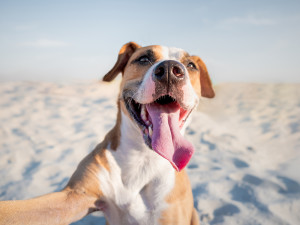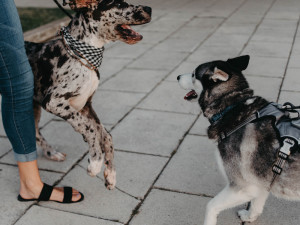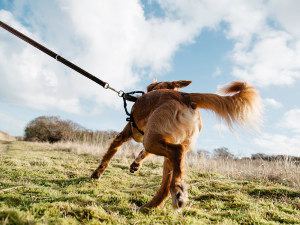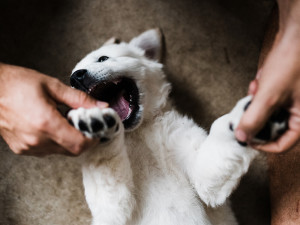Play or Aggression? How to Interpret a Dog Who’s Showing Teeth
It doesn’t always mean they’re upset.

Share Article
In This Article:
What a Dog Showing Their Teeth Meansopens in a new tab Origin of Grinning in Dogsopens in a new tab Misconceptions About Dogs Showing Their Teethopens in a new tab Six Reasons Why Dogs Show Their Teethopens in a new tab Submissive Grins vs. Warning Grinsopens in a new tab How to Respond to a Dog Showing Teethopens in a new tab Can You Train Your Dog to Smile?opens in a new tab
Seeing the corners of your dog’s mouth lift and their teeth appear in what looks like a goofy doggy grin never fails to make a pet parent smile. However, when those teeth are bared in a snarl, it elicits a very different reaction from pet parents because this body language can signal aggression. Interpreting your dog’s body language when they show their teeth is important for keeping your dog comfortable, as well as you and those around you safe.
Michelle Baker, founder and dog behavior specialist at Furkids Incopens in a new tab., a canine daycare and enrichment center, says dogs have an entire language of their own. “One of their more misunderstood signals is showing their teeth. Is it a friendly grin or a warning? That all depends on the context and the rest of their body language,” she says. “Sometimes, it’s a warning: ‘Back off, I’m uncomfortable.’ Other times, it’s a submissive gesture, almost like a nervous smile. And yes, some dogs do smileopens in a new tab.”
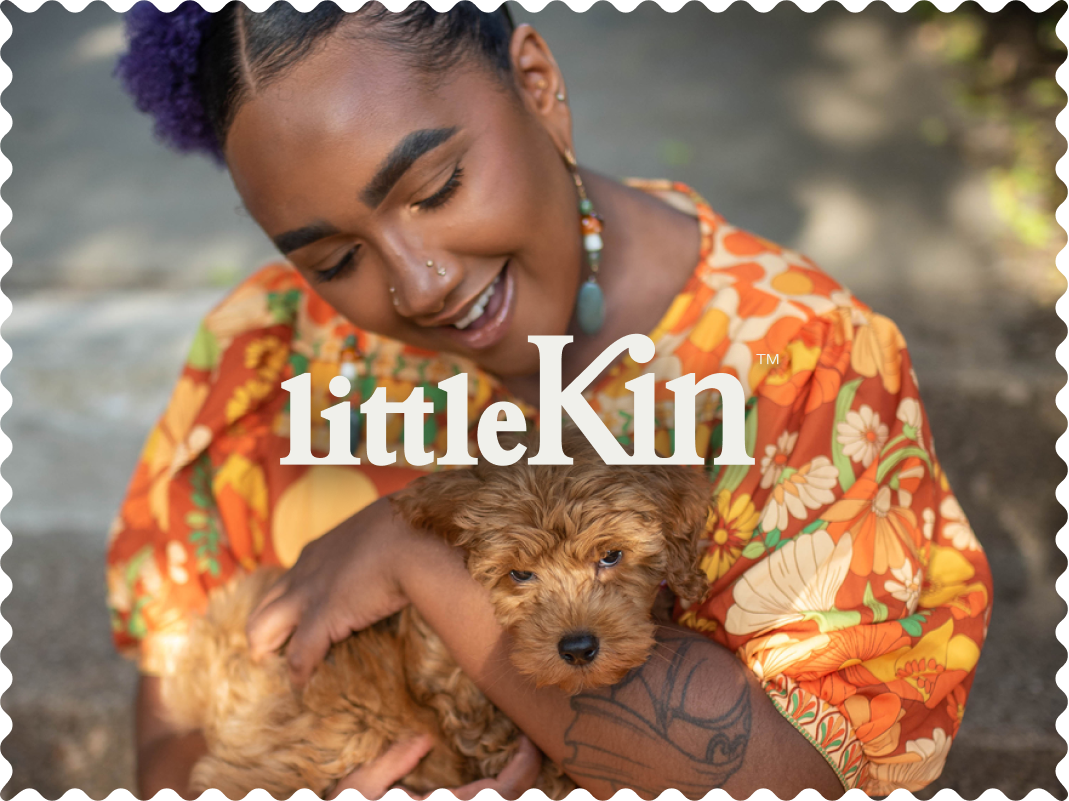
littleKin™ is Kinship’s home just for puppy and kitten parents. Bop over to check out expert advice, new pet tools, and special deals—all curated for your newest family member.
opens in a new tabBaker describes the submissive grin as a dog pulling back their lips like they’re cheesing for a photo. “It’s often seen in happy, friendly, and slightly nervous dogs trying to show they mean no harm,” she says.
Elisha Stynchula, a certified trainer and owner of “I Said Sit” School for Dogsopens in a new tab, says if a dog is growling while showing their teeth, they’re communicating aggression. “In the most common meaning, a dog showing teeth in a growl is representing a threat display, to let someone or some dog know that the snarling dog is unhappy with the current situation,” she says. Meanwhile, other dogs may “make a little snarl when they are displaying submissive behavior and deferring to a human or dog.”
What does it mean when a dog shows their teeth?
Laurie Hood, the founder of Alaqua Animal Refugeopens in a new tab, sees thousands of dogs come through her doors, each with their own unique story. “One of the most heartwarming sights is when a dog enters our refuge, tail wagging and flashing what we lovingly call a ‘happy dog smile,’ ” she says. “But we also see dogs who show their teeth out of fear, stress, or uncertainty.”
How can you tell the difference between a dog who’s truly smiling and one who’s warning you to keep your distance? “Dogs use body language to communicate: showing their teeth can mean very different things depending on the situation,” Hood says.
Origin of grinning in dogs
Baker says the idea of dogs grinning dates back to when they were first domesticated. She says researchers including Konrad Lorenz (a pioneer in studying domesticated animals), Raymond Coppinger (who wrote extensively on the domestication and evolution of dogs), and Brian Hare (who focuses on dog cognition and evolution) have posited that dogs who could mimic human expressions like a smile were favored over dogs that weren’t as good at reading and responding to human social cues.
“But can dogs truly smile in the way humans do?” Baker asks. “Not quite. Their version of a smile is more about body language and mimicking social cues that garner them positive attention. So, in a way, it’s kind of a symptom of happiness.”
Stynchula firmly believes some dogs in the community have developed grinning as a mimicking behavior. “There are also dogs who have been trained to show their teeth in a smile command that can be really cute to show off as a trick,” she says.
Common misconceptions about dogs showing teeth
The most common misconception is that any display of teeth equals aggression, Stynchula says. If you’re unsure, however, err on the side of caution. “Assume that it is aggressive rather than make the mistake and think that the dog is being submissive or displaying the rare doggy grin,” she says.
Baker agrees it’s a misconception that any time a dog shows their teeth, they must be aggressive. “Dogs show teeth for many reasons, including fear, stress, submission, playfulness, or even pain. The trick is looking at the whole picture — are they stiff and growling, or loose and wiggly? A stiff body, tense face, and direct stare along with bared teeth? That’s a warning. A dog showing teeth while play-bowing and bouncing around? That’s likely just playful excitement. They also may expose teeth during playtime as a way to correct unwanted behavior in another dog. It’s their way of saying ‘I don’t like this, please stop.’”
Similarly, does your dog’s growl always mean aggressionopens in a new tab? Sometimes, growling means dogs are working it outopens in a new tab. Hood adds that wagging does not always signal friendlinessopens in a new tab. “Tail position and speed matter. A slow, stiff wag can mean tension, and a fast, aggressive wag can indicate stress.”
Six common reasons why your dog is showing teeth
Fear
A fearful dogopens in a new tab may show their teeth as a defensive signal, Baker says. Accompanying signs of fear include a low body posture, wide eyes, and pinned ears.
Aggression
Along with teeth, signs of aggressionopens in a new tab include a stiff posture, a hard stare, growling, and raised hackles. “The teeth are a warning, telling you to back off,” Hood says.
Playfulness
Many dogs smile when they’re excited to see their favorite person. Play fightingopens in a new tab can be another reason for a friendly show of choppers. “When playing, some dogs will flash their teeth while wrestling or chasing, but their bodies remain loose and relaxed. This is often seen in social, confident dogs,” Hood says.
Stress or anxiety
Like a fearful or aggressive dog, an anxious dog may show their teeth.
Submissiveness
“Some dogs offer a submissive grin to show they mean no harm,” Hood says. “They’ll pull their lips back, wag their tails, and wiggle their whole body. This is an appeasement gesture, not a sign of aggression.”
Pain or discomfort
If a normally friendly dog suddenly starts baring teeth when touched or approached, this could indicate an injury or illness that needs veterinary attention, Hood says.
How do submissive grins and warning grins look different?
The difference between a submissive grinopens in a new tab and a warning grin depends on the rest of the picture. “What is the dog’s body language telling you?” Stynchula asks. A dog with an aggressive, warning grin is going to be displaying stiff, upright behavior with their ears forward or backopens in a new tab, depending on the individual dog. “In this case, there will likely be piloerection — when the hair is standing up on the dog’s back,” she says.
In a submissive display of teeth, the dog’s posture will likely resemble a crouch. “Many people mistake a submissive grin for aggression and vice versa, which is why it’s so important to look at the dog’s whole body language — not just their teeth,” Hood says.
How to respond when your dog shows teeth
Hood says Alaqua teaches adoptive dog parents that growling or teeth-baring is communication, not bad behavior. “A dog that’s punished for warning signs may learn to skip the warning and go straight to a bite,” she says.
Like Hood, Stynchula says the biggest piece of advice she gives is to never punish a dog when they’re showing their teeth and growling. “That sounds counterintuitive to so many pet parents. However, the growl is the dog’s first level of communication that it’s uncomfortable. If you push a dog that’s growling, you’re likely to get a bite. And if you punish a dogopens in a new tab that’s growling, you’re likely to end up with a dog who skips growling. Next time the comment will be, ‘He bit out of nowhere. There was no sign.’ ”
Baker suggests that you try to identify what’s making a dog uneasy and remove the stressor if possible. “Give them space, and don’t force interactions,” she says.
When to see a professional for aggression
If your dog is habitually displaying their teeth in a sign of aggression, the sooner you call a behaviorist, the better. “If a dog consistently shows teeth in a tense, warning manner — especially if it’s accompanied by lunging or snapping — it’s important to seek help from a professional behaviorist or veterinarian,” Hood says. “At Alaqua, we work with behaviorists to help rehabilitate dogs who need extra support before they’re ready for adoption.”
Baker says frequent, intense, and unpredictable growling and teeth-baring is a sign your dog is struggling with something bigger — fear, resource guardingopens in a new tab, stress, or even painopens in a new tab. “If there’s ever a bite involved, or if a dog is escalating in their warnings, it’s time to consult an expert before things get worse,” Baker says.
Can you train your dog to smile by showing teeth?
Some dogs, especially those prone to submissive grins, can learn to show their teeth in happy, controlled ways with positive reinforcementopens in a new tab, Baker says. “If a dog naturally grins when excited, you can pair it with a command like ‘smile’ and reward them with treats or praise. Just be sure not to encourage teeth-showing in a dog that tends to do it when stressed. It’s important to understand the ‘why’ behind the behavior before trying to shape it into a trick.”
Stynchula knows a dog who was trained to show his teeth in a big, silly looking grin. “That became his default behavior when he was greeting people. He was a big Labrador and not terribly scary, but it did make some people uncomfortable with his big old teeth-bearing grin,” she says.
Bottom line
At the end of the day, a dog’s smile, snarl, growl or tail wag is all about context, Baker says. “Watching their body language, energy, and the situation they’re in will tell you whether they’re feeling happy, worried, or playful. Understanding a dog’s body language and communication helps build a stronger, safer bond with our dogs, keeping communication clear and relationships thriving.”
FAQs
How to deal with a dog growling or showing teeth?
Growling and teeth-baring are methods of canine communication — not bad behavior — and should not be punished. Instead, identify what’s making a dog uneasy and try to address it.
What do I do if a dog I don’t know is showing their teeth?
Don’t overreact, and don’t punish the dog or yell at them. If you don’t know why the dog is baring their teeth — or they seem aggressive — carefully remove yourself from the situation.
Why does my dog show his teeth and wag their tail?
They’re greeting you. Dogs show their teeth in something like a smile and wag their tails to show they’re happy to see you.
Can dogs smile?
Dogs can be trained to smile, but a spontaneous display of teeth accompanied by loose, wiggly body language is a dog’s way of expressing joy. Other times, what looks like a smile is really a submissive grin.
Should I call the vet if my dog is showing more teeth than usual?
If your dog suddenly seems more tense and aggressive, the sooner you call a veterinarian or behaviorist, the better.
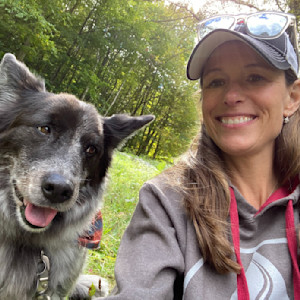
Catherine Fahy Green
Catherine Fahy Green is a journalist turned PR specialist whose work appears in numerous places as press releases and stories about fun products people should try. She lives with her family in Western Massachusetts where she listens closely to the stories her dogs, chickens, and horses tell her.
Related articles
![Great Dane puppy and Husky meeting on leash out side.]() opens in a new tab
opens in a new tabUnderstanding Reactivity and Aggression in Dogs: Two Very Different Things
Turns out, even experts have a hard time defining these terms.
- opens in a new tab
Does Your Dog Have Happy Tail Syndrome?
If your pup's exuberant tail wagging has led to injury, they could have this condition.
![Golden retriever puppy upside down playing with a mans hands and attempting to play bite.]() opens in a new tab
opens in a new tabHow to Train a Puppy Not to Bite
Those little razor teeth are no fun.
![Woman excitedly looking at her small dog with a ball in its mouth.]() opens in a new tab
opens in a new tab7 Signs Your Dog Is Excited
They’re just so hyped.

